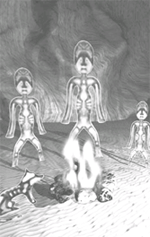Up in smoke
 the history of Australia is closely linked to the fires that have engulfed the continent for centuries. Captain James Cook who reached the Australian shores in 1770 described it as a "continent of smoke'. Some describe it as a land shaped by smoke ( New Scientist , Vol 162, No 2184). It is believed fire played a crucial role in the lives of Aborigines who arrived in Australia some 60,000 years ago, leading to extinction of large animals that once inhabited the continent.
the history of Australia is closely linked to the fires that have engulfed the continent for centuries. Captain James Cook who reached the Australian shores in 1770 described it as a "continent of smoke'. Some describe it as a land shaped by smoke ( New Scientist , Vol 162, No 2184). It is believed fire played a crucial role in the lives of Aborigines who arrived in Australia some 60,000 years ago, leading to extinction of large animals that once inhabited the continent.
However, there has always been a disagreement among scientists who believe that climate change was the cause of the megafauna extinctions, and those who argue that humans were responsible. The root cause of the disagreement is the difficulty in dating the fossil remains and human artefacts . A recent study by Gifford Miller and his colleagues at the University of Colorado at Boulder in the us has given a new dimension to the debate.
For those like Miller, Aborigine actions led to the extinction of animals like Procoptodon, a kangaroo that was three metres tall, a wombat-like creature that was as big as hippo, Wanabe , a snake nearly a metre in diameter and seven metres long, and Genyornis , a flightless bird twice as heavy as the emu. It is believed that in the epoch that ended with the last ice age, Pleistocene, about 10,000 years ago, every creature larger than the human disappeared.There has been an ongoing debate among scientists on precisely when the megafauna disappeared and why? The study by Miller and his team is the first of its kind to date the remains of the megafauna.
They analysed hundreds of fossil eggshell of Genyornis newtoni from Australia's arid interior. Miller says he has found evidence in the chemistry of the ancient eggshell that the Aborigines burnt Genyornis and other megafauna into extinction. Due to Australia's severe climate, organic matter quickly leaches out of the bone. This makes it impossible to run radiocarbon or other dating procedure directly on most fossils. Instead, investigators date bits of organic sediment found with the bones, a strategy with many uncertainties, because anything from floods to the movement of termite colonies may move fossil remains closer to older or younger sediments.
But the case of eggshells is different, as they have a different mineral structure to bones and they retain traces of protein. Miller, by using the technique of amino acid racemisation ( aar ), which is more reliable over a longer period of time compared to radiocarbon dating, has been able to date the eggshell directly. When animals synthesis protein, their bodies use only the left-handed isomer of the amino acid isoleucine. After death, the amino acid molecules begin inexorably to revert to the right-handed form.
In aar, the ratio of left-handed to right-handed isomers is used to determine the age of a fossil. The aar measurements done by Miller on fossil eggshells from Lake Eyre, Lake Frome and the confluence of the Darling and Murray rivers found the big bird had disappeared from the Australian interior about 50,000 years ago. This was a time of mild climate, long before the peak of the last ice age brought the cold, arid conditions to Australia.
"It is one of the major breakthroughs we have had in Australian prehistory,' says Tim Flannery, senior research scientist at the Australian Museum in Sydney. "It is unbelievable. He has 1,200 dates from three sites, the biggest data we have had.' Eggshells not only reveal when birds lived and died, they can also indicate what they ate, because shrubs and other woody plants contain a lower ratio of the stable isotope carbon-13 than annual grasses. Miller's group compared the carbon isotope signatures of fossil emu and Genyornis eggshells.
The results indicate that the emu, which is still present had a more flexible diet than Genyornis. "There were plenty of grasses available prior to the extinction event because some of the emus ate nothing but grass. None of the Genyornis living at the same time ate that much grass,'says Miller.
He argues that when people arrived on a continent already rich in fire-adapted vegetation, they began to use fire for their own purposes
Related Content
- Order of the National Green Tribunal regarding a dumping ground located at Debendra Chandra Nagar run by the Agartala Municipal Corporation, Tripura, 15/05/2025
- Report by Court Commissioner on Ghazipur landfill and waste to energy plant at the landfill, 29/03/2025
- Order of the National Green Tribunal regarding dumping yard at Baliapanda, Puri district, Odisha, 24/03/2025
- Order of the National Green Tribunal regarding unscientific handling and disposal of solid waste by the local bodies in Nagar Parishad, Jehanabad, Bihar, 09/01/2025
- Order of the National Green Tribunal regarding air pollution caused by traditional wood pyre cremation methods in Howrah and Kolkata, West Bengal, 02/01/2025
- Reply by the BMC regarding pollution by PNG cemetery at Borivali, Mumbai, Maharashtra, 11/12/2024
